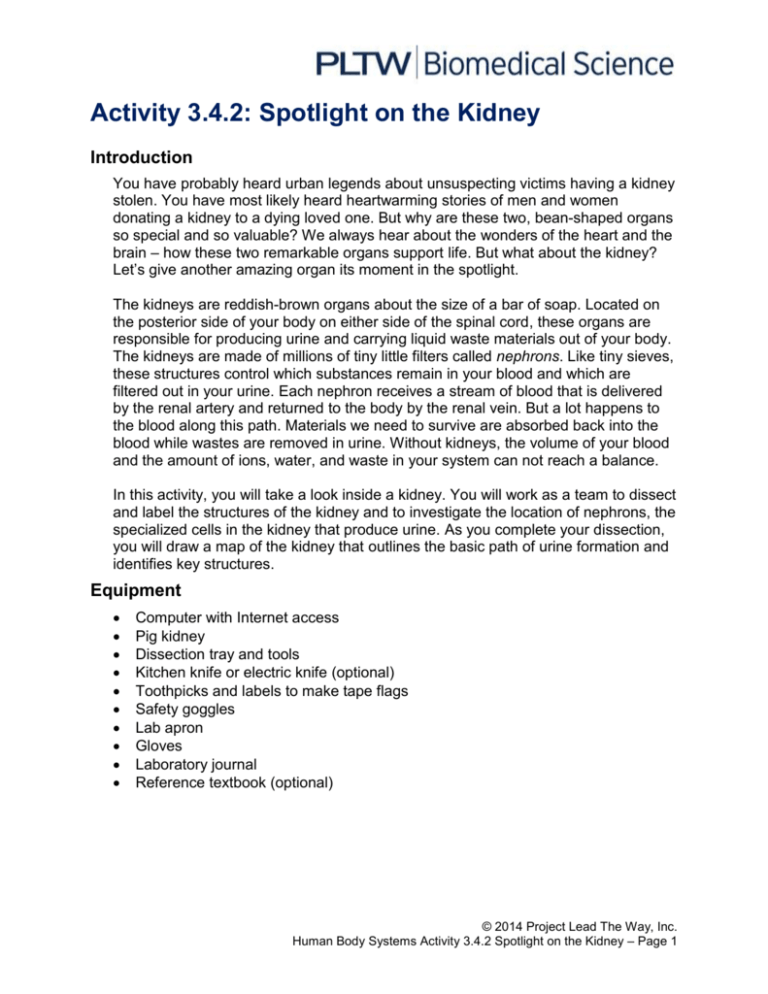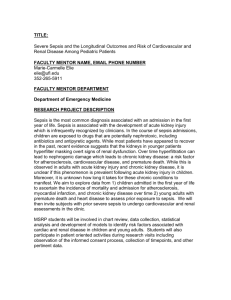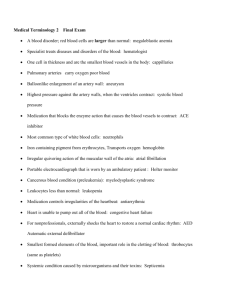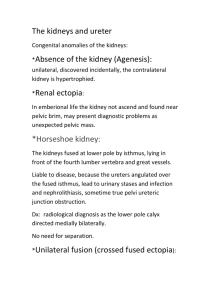3.4.2 Kidney - Project Lead the Way: Biomedical Sciences
advertisement

Activity 3.4.2: Spotlight on the Kidney Introduction You have probably heard urban legends about unsuspecting victims having a kidney stolen. You have most likely heard heartwarming stories of men and women donating a kidney to a dying loved one. But why are these two, bean-shaped organs so special and so valuable? We always hear about the wonders of the heart and the brain – how these two remarkable organs support life. But what about the kidney? Let’s give another amazing organ its moment in the spotlight. The kidneys are reddish-brown organs about the size of a bar of soap. Located on the posterior side of your body on either side of the spinal cord, these organs are responsible for producing urine and carrying liquid waste materials out of your body. The kidneys are made of millions of tiny little filters called nephrons. Like tiny sieves, these structures control which substances remain in your blood and which are filtered out in your urine. Each nephron receives a stream of blood that is delivered by the renal artery and returned to the body by the renal vein. But a lot happens to the blood along this path. Materials we need to survive are absorbed back into the blood while wastes are removed in urine. Without kidneys, the volume of your blood and the amount of ions, water, and waste in your system can not reach a balance. In this activity, you will take a look inside a kidney. You will work as a team to dissect and label the structures of the kidney and to investigate the location of nephrons, the specialized cells in the kidney that produce urine. As you complete your dissection, you will draw a map of the kidney that outlines the basic path of urine formation and identifies key structures. Equipment Computer with Internet access Pig kidney Dissection tray and tools Kitchen knife or electric knife (optional) Toothpicks and labels to make tape flags Safety goggles Lab apron Gloves Laboratory journal Reference textbook (optional) © 2014 Project Lead The Way, Inc. Human Body Systems Activity 3.4.2 Spotlight on the Kidney – Page 1 Procedure 1. With your partner, use the Internet or reference textbooks to find a clear picture or diagram of the inside of the kidney. Search for reliable websites and print out helpful graphics. 2. Locate a simple diagram of the nephron. Print out this diagram and attach it in your laboratory journal. If the diagram is from a textbook, sketch the labeled diagram in your laboratory journal. Think about how these tiny units are organized inside of the kidney. 3. Research the structure and function of the following structures as well as their location in/on the kidney. Items marked with a * are specific parts of the nephron. You will not be able to see these exact structures in your dissection, but you should research where in the kidney (the pelvis, medulla or cortex) these parts of the nephron would be located. o o o o o o o o o Renal Pelvis Renal Medulla Renal Cortex Medullary Pyramid Ureter Calyx Renal Capsule Site of the Glomerulus and Bowman’s capsule* Site of Collecting Ducts and Loop of Henle* 4. Create a tape flag label for each of the above structures. 5. Put on safety equipment. 6. Obtain a pig kidney from your teacher and place it in a dissecting tray. Observe the external anatomy of the organ. 7. Using a very sharp scalpel, carefully cut the kidney open lengthwise, like you were opening a book – leaving the two sides attached. Your teacher may want you to complete this cut using an electric knife or a kitchen knife. Make sure to follow the teacher’s instructions for using this tool or allow your teacher to complete the cut. 8. Explore the internal anatomy of the kidney and begin to connect specific structures with their role in the production of urine. 9. Work with your partner to locate and label the listed structures and place the toothpick flags in the appropriate area. 10. As you identify key structures, discuss and research the questions listed below. Write the questions and your answers in your laboratory journal. o o o o In which sections or section of the kidney is the urine formed? What section of the kidney collects the urine? How does the urine move from the kidney out of the body? In which main regions of the kidney are the glomerulus and the Bowman’s capsule located? o In which main regions of the kidney are the collecting ducts and the loop of Henle located? © 2014 Project Lead The Way, Inc. Human Body Systems Activity 3.4.2 Spotlight on the Kidney – Page 2 11. Check your flag placement with your teacher. 12. Make a record of your work. On a blank page in your laboratory journal, draw a large “map” of your kidney. Draw and identify key structures from your dissection. Your map should allow a traveler to follow the path of blood entering the kidney and to observe and appreciate key landmarks along the way. Use arrows to show the path of urine formation and its departure from the body. Create road signs along the way that label key structures and provide a brief description of function. 13. At one point in you map, show a magnified section highlighting the nephron. Identity key structures of the nephron. Do not worry about the function of each section at this point. You will study what happens to molecules and fluids across the nephron in the next activity. 14. Dispose of waste as instructed by your teacher. 15. Clean your tray and dissecting tools and return them to the designated area. 16. Complete the conclusion questions. Conclusion 1. Order the following kidney structures to show the path of urine formation and its departure from the body: renal pelvis, glomerulus, ureter, renal artery, bladder, renal tubules (Loop of Henle and collecting ducts), calyx, urethra, Bowman’s capsule. 2. How will other body systems be affected if the kidneys begin to shut down? Explain your answer. 3. If you stretched the nephrons in a kidney from end to end, they would be over 40 miles long! Explain how this structure directly relates to the function of the kidney. © 2014 Project Lead The Way, Inc. Human Body Systems Activity 3.4.2 Spotlight on the Kidney – Page 3 4. Suggest reasons why we can live with one kidney, but we are born with two. © 2014 Project Lead The Way, Inc. Human Body Systems Activity 3.4.2 Spotlight on the Kidney – Page 4









